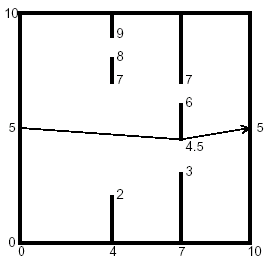POJ1556 The Doors [线段相交 DP]
| Time Limit: 1000MS | Memory Limit: 10000K | |
| Total Submissions: 8334 | Accepted: 3218 |
Description

Input
2
4 2 7 8 9
7 3 4.5 6 7
The first line contains the number of interior walls. Then there is a line for each such wall, containing five real numbers. The first number is the x coordinate of the wall (0 < x < 10), and the remaining four are the y coordinates of the ends of the doorways in that wall. The x coordinates of the walls are in increasing order, and within each line the y coordinates are in increasing order. The input file will contain at least one such set of data. The end of the data comes when the number of walls is -1.
Output
Sample Input
1
5 4 6 7 8
2
4 2 7 8 9
7 3 4.5 6 7
-1
Sample Output
10.00
10.06
Source
题意:从(0,5)走到(10,5)最短路
我太傻逼了,查了好长时间计算几何的错,结果是求DAG的DP忘清空vis了
#include <iostream>
#include <cstdio>
#include <cstring>
#include <algorithm>
#include <cmath>
#include <vector>
using namespace std;
typedef long long ll;
const int N=,M=1e4+;
const double INF=1e9;
const double eps=1e-;
inline int read(){
char c=getchar();int x=,f=;
while(c<''||c>''){if(c=='-')f=-; c=getchar();}
while(c>=''&&c<=''){x=x*+c-''; c=getchar();}
return x*f;
}
inline int sgn(double x){
if(abs(x)<eps) return ;
else return x<?-:;
}
struct Vector{
double x,y;
Vector(double a=,double b=):x(a),y(b){}
bool operator <(const Vector &a)const{
return x<a.x||(x==a.x&&y<a.y);
}
void print(){
printf("%lf %lf\n",x,y);
}
};
typedef Vector Point;
Vector operator +(Vector a,Vector b){return Vector(a.x+b.x,a.y+b.y);}
Vector operator -(Vector a,Vector b){return Vector(a.x-b.x,a.y-b.y);}
Vector operator *(Vector a,double b){return Vector(a.x*b,a.y*b);}
Vector operator /(Vector a,double b){return Vector(a.x/b,a.y/b);}
bool operator ==(Vector a,Vector b){return sgn(a.x-b.x)==&&sgn(a.y-b.y)==;} double Cross(Vector a,Vector b){
return a.x*b.y-a.y*b.x;
}
double DisPP(Point a,Point b){
Point t=a-b;
return sqrt(t.x*t.x+t.y*t.y);
}
struct Line{
Point s,t;
Line(){}
Line(Point p,Point v):s(p),t(v){}
}l[N];
int cl;
bool isLSI(Line l1,Line l2){
Vector v=l1.t-l1.s,u=l2.s-l1.s,w=l2.t-l1.s;
return sgn(Cross(v,u))!=sgn(Cross(v,w))&&sgn(Cross(v,u))!=&&sgn(Cross(v,w))!=;
}
bool isSSI(Line l1,Line l2){
return isLSI(l1,l2)&&isLSI(l2,l1);
}
bool can(Point a,Point b){
Line line(a,b);
for(int i=;i<=cl;i++)
if(isSSI(l[i],line)) return false;
return true;
} int n,s,t;
struct edge{
int v,ne;
double w;
}e[M<<];
int h[N],cnt=;
inline void ins(int u,int v,double w){//printf("ins %d %d %lf\n",u,v,w);
cnt++;
e[cnt].v=v;e[cnt].w=w;e[cnt].ne=h[u];h[u]=cnt;
}
double d[N];
int vis[N]; double dp(int u){
if(vis[u]) return d[u];
vis[u]=;
for(int i=h[u];i;i=e[i].ne){
int v=e[i].v;
d[u]=min(d[u],dp(v)+e[i].w);
}
return d[u];
}
void DAG(){
for(int i=s;i<=t;i++) d[i]=INF;
memset(vis,,sizeof(vis));
d[t]=;vis[t]=;
dp(s);
} Point p[N][];
Point S(,),T(,);
inline int idx(int u){return u%==?u/:u/+;}
inline int idy(int u){return u%==?:u%;}
double x;
int main(int argc, const char * argv[]) {
while(true){
n=read();s=;t=*n+;
if(n==-) break;
cnt=;memset(h,,sizeof(h));
cl=; for(int i=;i<=n;i++){
scanf("%lf%lf%lf%lf%lf",&x,&p[i][].y,&p[i][].y,&p[i][].y,&p[i][].y);
p[i][].x=p[i][].x=p[i][].x=p[i][].x=x;
int num=(i-)*;
//for(int j=1;j<=4;j++) p[i][j].print();
if(i==){
for(int j=;j<=;j++)
ins(s,num+j,DisPP(S,p[i][j]));
}else{
for(int j=;j<=;j++){
for(int u=;u<=num;u++){
if(can(p[idx(u)][idy(u)],p[i][j]))
ins(u,num+j,DisPP(p[idx(u)][idy(u)],p[i][j]));
}
if(can(S,p[i][j])) ins(s,num+j,DisPP(S,p[i][j]));
}
}
l[++cl]=Line(Point(x,),p[i][]);
l[++cl]=Line(p[i][],p[i][]);
l[++cl]=Line(p[i][],Point(x,));
}
int num=n*;
for(int u=;u<=num;u++)
if(can(p[idx(u)][idy(u)],T))
ins(u,t,DisPP(p[idx(u)][idy(u)],T));
if(can(S,T)) {puts("10.00");continue;}
DAG();
printf("%.2f\n",d[s]);
} return ;
}
POJ1556 The Doors [线段相交 DP]的更多相关文章
- POJ1556 最短路 + 线段相交问题
POJ1556 题目大意:比较明显的题目,在一个房间中有几堵墙,直着走,问你从(0,5)到(10,5)的最短路是多少 求最短路问题,唯一变化的就是边的获取,需要我们获取边,这就需要判断我们想要走的这条 ...
- POJ 1556 - The Doors 线段相交不含端点
POJ 1556 - The Doors题意: 在 10x10 的空间里有很多垂直的墙,不能穿墙,问你从(0,5) 到 (10,5)的最短距离是多少. 分析: 要么直达,要么 ...
- POJ 1556 The Doors【最短路+线段相交】
思路:暴力判断每个点连成的线段是否被墙挡住,构建图.求最短路. 思路很简单,但是实现比较复杂,模版一定要可靠. #include<stdio.h> #include<string.h ...
- 简单几何(线段相交+最短路) POJ 1556 The Doors
题目传送门 题意:从(0, 5)走到(10, 5),中间有一些门,走的路是直线,问最短的距离 分析:关键是建图,可以保存所有的点,两点连通的条件是线段和中间的线段都不相交,建立有向图,然后用Dijks ...
- POJ 1066 Treasure Hunt (线段相交)
题意:给你一个100*100的正方形,再给你n条线(墙),保证线段一定在正方形内且端点在正方形边界(外墙),最后给你一个正方形内的点(保证不再墙上) 告诉你墙之间(包括外墙)围成了一些小房间,在小房间 ...
- 简单几何(线段相交) POJ 1066 Treasure Hunt
题目传送门 题意:从四面任意点出发,有若干障碍门,问最少要轰掉几扇门才能到达终点 分析:枚举入口点,也就是线段的两个端点,然后选取与其他线段相交点数最少的 + 1就是答案.特判一下n == 0的时候 ...
- poj 1066 线段相交
链接:http://poj.org/problem?id=1066 Treasure Hunt Time Limit: 1000MS Memory Limit: 10000K Total Subm ...
- POJ 1066 Treasure Hunt(线段相交判断)
Treasure Hunt Time Limit: 1000MS Memory Limit: 10000K Total Submissions: 4797 Accepted: 1998 Des ...
- 线段相交 poj 1066
// 线段相交 poj 1066 // 思路:直接枚举每个端点和终点连成线段,判断和剩下的线段相交个数 // #include <bits/stdc++.h> #include <i ...
随机推荐
- gulp + es6 + babel+ angular 搭建环境并实现简单的路由
1.ECMAscript 6的语法糖面临的唯一问题就是浏览器兼容的问题,使得很多程序员望而怯步. 2.babel的作用就是将es6的语法编译成es5被浏览器所识别.这样就可以任性的使用es6了. 3. ...
- android studio无法识别含有rcs包名的jar
http://blog.csdn.net/JingleYe/article/details/70048943 android studio无法识别含有rcs包名的jar android stu ...
- QQ群友在线/离线,如何测试?
上篇文章『QQ好友在线/离线,如何测试?』针对即时通讯的"状态"进行了分析和总结,主要说到了QQ好友在线/离线实现方案,测试过程中需要注意的测试点. 针对好友状态实时性的要求需要使 ...
- ASP.NET CORE MVC 2.0 项目中引用第三方DLL报错的解决办法 - InvalidOperationException: Cannot find compilation library location for package
目前在学习ASP.NET CORE MVC中,今天看到微软在ASP.NET CORE MVC 2.0中又恢复了允许开发人员引用第三方DLL程序集的功能,感到甚是高兴!于是我急忙写了个Demo想试试,我 ...
- sudo 无效命令
mac系统中由于不小心修改了/etc/sudoers下的权限为777,故而sudo命令不能使用. 解决办法 1.重新启动mac并且按command+s进入单用户界面 2.此时默认的系统状态是只读状态, ...
- Java 调用python说明文档
Java 调用python说明文档 通过java调用python脚本主要如下三种方式: 1.直接执行python脚本: 2.执行python.py文件: 3.使用Runtime.getRuntime( ...
- 转-How to install an SSH Server in Windows Server 2008
window也可以通过ssh客户端连接,具体方式参考下面 1 How to install an SSH Server in Windows Server 2008 2 freeSSHd and fr ...
- 壮美大山包-2017中国大山包国际超百公里ITRA积分赛赛记
2017年4月份用时28个多小时跑完江南100,付出的代价是双脚多达8个以上的水泡.所以接下来的4月29日的环汶川越野赛果断的从60公里换到了30公里组,慢悠悠的完成了. 虽然在赛道上一度想再也不参加 ...
- Linux常用命令(一)--系统命令
命令字 命令字 [命令选项] [命令参数] 1. 命令中所有字符区分大小写 2. 命令选项分为短格式(-)及长格式(–) 3. 必须在命令行提示符下输入命令 4. 命令中的各个部分至少需要一个空格分隔 ...
- java 中的instanceof
java 中的instanceof 运算符是用来在运行时指出对象是否是特定类的一个实例.instanceof通过返回一个布尔值来指出,这个对象是否是这个特定类或者是它的子类的一个实例. 用法:resu ...
